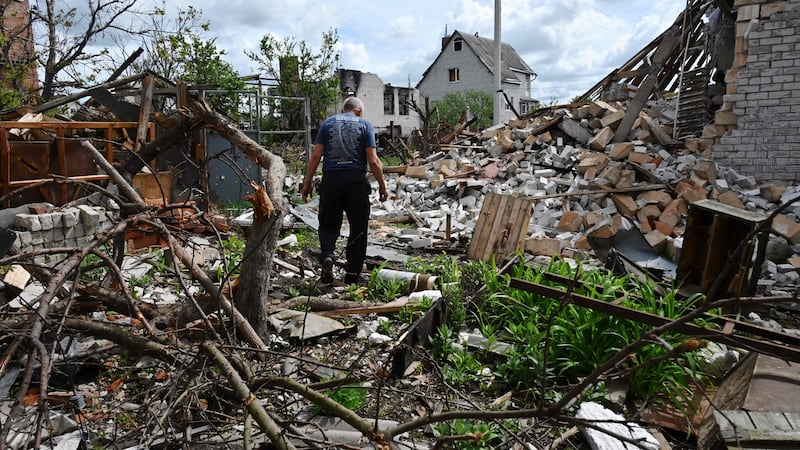Russia said on Monday that it had agreed to evacuate wounded Ukrainian soldiers from the bunkers below the besieged Azovstal steelworks in Mariupol to a medical facility in the Russian-controlled town of Novoazovsk.
“An agreement has been reached on the removal of the wounded,” the Russian defence ministry said in a statement.
“A humanitarian corridor has been opened through which wounded Ukrainian servicemen are being taken to a medical facility in Novoazovsk.”

As Russian forces pummelled Mariupol for nearly two months, some civilians and Ukrainian fighters sought refuge in the Azovstal works – a vast Soviet-era plant founded under Josef Stalin and designed with a labyrinth of bunkers and tunnels to withstand attack.
Most civilians were evacuated from the plant this month after the United Nations and the International Committee of the Red Cross brokered a deal with Russia and Ukraine.
But Ukrainian fighters remain at the plant. Videos and pictures posted online show some of the fighters have serious injuries.
On Sunday, brightly burning white munitions were seen cascading down on the steel works in what a British military expert said looked like an attack with phosphorus or other incendiary weapons.
Relatives appealed on Monday to Turkish president Tayyip Erdogan in Istanbul to help extract the defenders.
Natalia Zaritskaya, wife of a member of the Ukrainian Azov Battalion, told reporters: “The ring around Azovstal has tightened. We can’t delay any further. We pin our last hope and believe that through the joint efforts of Turkey, through its President Erdogan, and China, through its President Xi Jinping, and God himself, it is possible to save Azovstal and the people who are there on the cusp of life and death.
“They are in hell. They receive new wounds every day. They are without legs or arms, exhausted, without medicines.”

Pushed back
Also on Monday, Ukrainian officials said their troops have pushed Russian forces back from the northeastern city of Kharkiv and some have advanced as far as the border with Russia.
The developments, if confirmed, would signal a further shift in momentum in favour of Ukraine nearly three months into a conflict that began when Russia sent tens of thousands of troops over the border into Ukraine on February 24th.
Sweden meanwhile has said it has made a formal decision to apply to join Nato following a similar move by Finland on Sunday – a change in the Nordic countries' long-standing policy of neutrality brought on by the Russian invasion and concern about president Vladimir Putin's wider ambitions.
"Europe, Sweden and the Swedish people are living now in a new and dangerous reality," Swedish prime minister Magdalena Andersson said during a debate in parliament in Stockholm.
In another setback for Putin, McDonald’s Corp, the world’s largest fast food chain, said it was pulling out of Russia because of the conflict.
In Brussels, the European Union was working on a package of further economic sanctions on Russia to step up international pressure on Putin.
Counter-offensive
On the battlefields near Kharkiv, Ukraine’s second-largest city, interior ministry adviser Vadym Denisenko said Ukrainian troops were mounting a counter-offensive.
“It can no longer be stopped ... Thanks to this, we can go to the rear of the Russian group of forces,” he said.
Kharkiv, lying about 50 km from the border with Russia, had endured weeks of heavy Russian bombardments. The Russian retreat from the city follows their failure to capture the capital Kyiv in the early stages of the war.
But thousands of people, including many civilians, have been killed across the country, cities have been blasted into ruins, and more than six million people have fled their homes to seek refuge in neighbouring states in scenes not seen in Europe since the Balkan wars of the 1990s.
Russia denies targeting civilians.
Ukraine’s defence ministry said on Monday the 227th Battalion of the 127th Brigade of Ukraine’s Territorial Defence Forces had reached the border with Russia.
Kharkiv region governor Oleh Sinegubov said the troops had restored a sign on the border.
“We thank everyone who, risking their lives, liberates Ukraine from Russian invaders,” Mr Sinegubov said.
Reuters could not verify Ukraine’s account and it was not clear how many troops had reached the Russian border or where.
If confirmed, it would suggest the northeastern counter-offensive is having increasing success after western military agencies said Moscow’s offensive in two eastern provinces known as the Donbas had stalled.
Not surprised
Konrad Muzyka, director of the Poland-based Rochan consultancy, said he was not surprised at the Ukrainian gains.
“The Ukrainians have been in the border regions for a few days already,” he told Reuters. “It’s symbolic and it definitely has PR value, but this was to be expected.
“Don’t get me wrong, the Russians still enjoy overall artillery superiority in terms of numbers, but I’m not sure if the same goes for the quality now.”
The governor of the Luhansk region in Donbas, Serhiy Gaidai, said the situation “remains difficult”, with Russian forces trying to capture the town of Sieverodonetsk.
He said leaders of the Lugansk People’s Republic, the territory in Luhansk controlled by Russian-backed separatists, declared a general mobilisation, adding it was “either fight or get shot, there is no other choice”.
In the south, fighting was raging around the city of Kherson and Russian missiles struck residential areas of Mykolayiv, the presidential office in Kyiv said. Reuters was unable to verify the reports.
Nato Secretary-General Jens Stoltenberg said on Sunday Ukraine could win the war, an outcome few military analysts predicted when Russia invaded Ukraine. – Reuters









